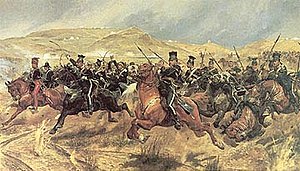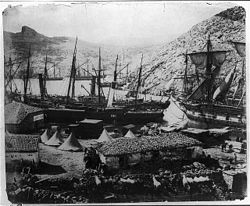Battle of Balaklava
| date | October 25, 1854 |
|---|---|
| place | Balaklava , Crimea |
| output | draw |
| Parties to the conflict | |
|---|---|
| Commander | |
| Troop strength | |
| 20,000 men | 23,000 men |
| losses | |
|
600 dead and wounded |
1,000 dead and wounded |
Olteniţa - Akhaltsikhe - Başgedikler - Sinope - Cetate - Silistra - Nigojeti - Tscholok - Odessa - Kurekdere - Petropavlovsk-Kamchatsky - Alma - Sevastopol - Bomarsund - Balaklava - Inkerman - Yevpatoria - Taganrog - Çorğun - Kars - Tschernaja - Malakoff - Kinburn - Third Paris peace
The Battle of Balaklava was a military conflict on October 25, 1854 between the Allies ( British , French , Ottoman Empire ) and the Russian Empire during the siege of Sevastopol in the Crimean War . It gained fame through two incidents that have entered British usage , The Thin Red Line and the Light Brigade attack .
Background and starting position
The battle took place almost seven weeks after the British, French and a Turkish contingent landed in Crimea. During the siege of Sevastopol , the British were based in the port city of Balaklava . That is why they later (1855) built the first strategic railway line in the history of warfare here in order to transport their supplies from Balaklava to the camp of the British-French siege army outside Sevastopol.
In front of the city are two parallel valleys, the north and south valleys. Both are separated by a range of hills called Kadikoj Heights or Causeway Heights. On these hills, nearly two miles from their positions, the Allies had erected four redoubts . These were manned by 3,000 Turks and equipped with nine twelve-pounder guns. The 93rd Highlander Regiment blocked the road to Balaklava near the village of Kadikoj. The light and heavy British cavalry brigades stood at the foot of the range of hills, with the French cavalry and artillery directly to the northwest . The Russians had brought in a relief army from Bessarabia and assembled about 8 kilometers away with 25,000 men and 78 cannons under their commander, Count Liprandi .
Structure of the armies
Allies
-
British Army ( Lord Raglan )
- Cavalry Division ( Lord Lucan )
- heavy brigade ( Scarlett )
- light brigade ( Earl of Cardigan )
- 1st Infantry Division ( George, 2nd Duke of Cambridge )
- Guards Brigade ( Bentinck )
- Highland Brigade (Garrison Balaklava) ( Colin Campbell )
- 4th Infantry Division ( Cathcart )
- 1st Brigade (Goldie)
- 2nd Brigade ( Torrens )
- Cavalry Division ( Lord Lucan )
- French Army ( Canrobert )
Total strength: 20,000 men, 41 guns
Russians
- Russian Army ( Liprandi )
The course of the battle
The Thin Red Line
At five in the morning Liprandi set off with two-thirds of his troops. He first occupied Fedioukine Heights, opposite the Allied positions on Causeway Heights, and then attacked the three eastern fortifications. After initial resistance, the Ottoman soldiers gave up the positions and retreated to the western fortifications. Around 7 a.m. the way to Balaklava harbor seemed to be clear. However, the Russians hesitated, so Lord Raglan had time to bring his troops up. The 93rd (Sutherland) Highlanders , under Sir Colin Campbell , formed in two lines ( The Thin Red Line ) and advanced on the heights towards the Redouten. A total of 700 British and 1,000 Turks withstood the attack by 2,300 Russians.
The Heavy Brigade attack
Raglan ordered Brigadier James Yorke Scarlett and his heavy cavalry brigade to fall into the flank of the Russians. This attacked the Russians and in a successful attack dispersed the three times stronger Russian hussars . The Duke of Cambridge's 1st Division, Cathcarts 4th Division, Bosquet's French Division and the Chasseurs d'Afrique Brigade arrived around 10:30 am .
Lord Raglan had a good view of the battlefield in the valley and on the hills from a plateau to the west. When he saw the Heavy Brigade attack the Russian cavalry, he sent the 4th Division to attack the Russians in the flank. This led to the almost fleeting retreat of the Russians. Raglan then wrote Scarlett a simple message, Well done, Scarlett. In order to take advantage of the success and to win back the cannons captured by the Russians, he now decided to use the light cavalry.
The Light Brigade attack
The attack of the Light Brigade (English Charge of the Light Brigade ) is considered to be the peculiarity of this battle, which also led to its relative fame. Due to misunderstandings in the transmission of orders, the light brigade under Lord Cardigan attacked the well-fortified positions at the end of the northern valley. On the Causeway Heights, which closed the valley to the south, there were also the gun emplacements captured by the Russians that morning, while the Fedioukine Heights on the north side of the valley had been occupied by the Russians without resistance.
The attack began with 673 men from the 13th Dragoons , 17th Lancers and 11th Hussars . The French General Bosquet commented on the picture of the troops galloping under fire from the front and from both sides with the now famous words: " C'est magnifique, mais ce n'est pas la guerre, c'est de la folie. »(German:“ That's great, but that's not war, it's madness. ”) 200 men of the attackers actually reached the cannon positions and, to the astonishment of the Russians, began to attack them. In the end, however, they had to retreat before a counter-attack by the Russian heavy cavalry. A total of 156 Light Brigade men were killed and 122 wounded in the attack.
The second day
On October 26th, 8,000 men fell out of the besieged city. After initial success, however, they were thrown back by the British 2nd Division. During these battles, however, no more fighting took place at Balaklava.
Result and consequences

The outcome of the battle can be counted as a tie, even if the Russians had an advantage in conquering the three fortifications. However, the battle had no further significance for the further course of the war. After six weeks the conquered positions near Balaklava were evacuated by the Russians.
The battle seals of Alfred Tennyson and others have mystified this battle, and particularly the attack by the Light Brigade. For a long time it was believed that the light brigade was completely wiped out or reduced to a third during the attack. Due to the high loss of horses, only 195 riders were actually ready to go. The losses suffered were heavy, but not uncommon for a cavalry attack. Failure is also seen as the beginning of the decline of the cavalry as an effective weapon. Until the development of motorized units, however, the speed of the cavalry for reconnaissance and encirclement remained of great military importance.
Friedrich Engels judged the use of British infantry:
“An English battle line does what has hardly been done by any other infantry: receive cavalry in line, keep their muskets loaded until the last moment, and only fire a shower of bullets when the enemy has approached within 30 yards, and almost always with them the greatest success. The British infantry fire with such cold-bloodedness, even at the most critical moment, that their fire surpasses that of all other troops in its effect. So the highlands, formed in line, drove the Russian cavalry back at Balaklava. "
Entry into parlance
Some terms from the Battle of Balaklava found their way into the English vocabulary:
- Charge of the Light Brigade is still used today to ironically mark an undertaking that is carried out with great courage and high discipline, but with inadequate preparation and unsuitable means. Failure is seen not only as likely, but as certain.
- The resistance of the Highlander stands as The Thin Red Line for withstanding a superior force.
- Ski masks are also called balaclavas or balaclava helmets in English , as these items of clothing were used in the Crimean War and thus also in Balaklava due to the extreme cold .
Film history
The attack of the light brigade provided the template for feature films at least twice: in 1936 for the American film Der Verrat des Surat Khan (original title: The Charge of the Light Brigade ) by Michael Curtiz and in 1968 for the British film The attack of the light brigade (original title also The Charge of the Light Brigade ) by Tony Richardson .
literature
- Orlando Figes: “Crimea. The Last Crusade ”, London 2010, ISBN 978-0-7139-9704-0 .
- German Werth: THE CRIME WAR , Frankfurt / M. 1989, ISBN 3-548-34949-8 .
- John & Boris Mollo: Into the Valley of Death , London 1991, ISBN 1-872004-75-X .
- Alexander Rodger Battle Honors of the British Empire , 2003, ISBN 1-86126-637-5 .
- Kinglake, The Invasion of the Crimea (nine volumes), London 1863–87, ISBN 978-1-84342-497-0 .
- Karl Marx - Friedrich Engels - Werke, Berlin 1961, ISBN 3-320-00206-6 .
- Alfred Baron Tennyson - "The Attack by Horsemen from Balaklawa" (translated into German by A. Strodtmann, approx. 1900)
Web links
Individual evidence
- ↑ John Duncan: Heroes for Victoria . Spellmount LTD, Tunbridge Wells 1991, ISBN 0-946771-38-3 , pp. 57 .
- ^ Clive Ponting: The Crimean War. The Truth Behind the Myth. Chatto & Windus, London 2004, ISBN 0-7011-7390-4 .
- ^ Karl Marx - Friedrich Engels - Works, Volume 11, pp. 409-480.



